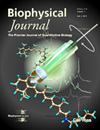微血管中细胞滚动速度分布的键合动力学决定因素的跨尺度分析。
IF 3.1
3区 生物学
Q2 BIOPHYSICS
引用次数: 0
摘要
剪切流动下亚细胞粘附动力学和细胞尺度变形之间的相互作用驱动了关键的生理和病理过程。虽然结合动力学和流体-细胞相互作用已经在滚动粘附中得到了广泛的研究,但结合特性如何定量地决定细胞速度分布仍不清楚。在本研究中,我们以宏观速度分布为参考,系统地研究了无力键动力学和内在力学性能如何影响滚动粘附动力学。通过将浸入边界法与随机粘附动力学相结合,我们模拟了细胞在具有受体-配体相互作用的直微管内的滚动和变形。我们的研究结果表明,当键形成概率超过临界阈值(对应于细胞表面的键饱和度)时,速度分布从对数正态曲线过渡到正态曲线。观察到非应力键的开/关率对速度分布的非线性影响,不同键类型具有不同的饱和阈值。与线性(Hookean)键相比,非线性键(通过蠕虫状链框架建模)在饱和状态下表现出更少的表面键。这些跨尺度的键动力学分析为通过滚动行为解释细胞力学表型提供了关键的见解。本文章由计算机程序翻译,如有差异,请以英文原文为准。
A cross-scale analysis for the determinants of bonding dynamics on the distributions of rolling velocities of cells in microvessels.
The interplay between subcellular adhesion dynamics and cellular-scale deformations under shear flow drives key physiological and pathological processes. While both bond kinetics and fluid-cell interactions have been extensively studied in rolling adhesion, how bond characteristics quantitatively determine cellular velocity distributions remains unclear. In this study, we systematically investigate how force-free bond kinetics and intrinsic mechanical properties govern rolling adhesion dynamics, using macroscopic velocity distributions as a reference. By coupling the immersed boundary method with stochastic adhesion dynamics, we simulate rolling and deforming cells in straight microtubes with receptor-ligand interactions. Our results reveal that velocity distributions transition from log-normal to normal profiles when bond formation probabilities exceed a critical threshold, corresponding to bond saturation on the cell surface. Nonlinear effects of unstressed bond on/off rates on velocity distributions are observed, with distinct saturation thresholds for different bond types. Nonlinear bonds (modeled via the worm-like chain framework) exhibit fewer surface bonds at saturation compared to linear (Hookean) bonds. These cross-scale analyses of bond dynamics provide critical insights into interpreting cellular mechano-phenotypes through rolling behavior.
求助全文
通过发布文献求助,成功后即可免费获取论文全文。
去求助
来源期刊

Biophysical journal
生物-生物物理
CiteScore
6.10
自引率
5.90%
发文量
3090
审稿时长
2 months
期刊介绍:
BJ publishes original articles, letters, and perspectives on important problems in modern biophysics. The papers should be written so as to be of interest to a broad community of biophysicists. BJ welcomes experimental studies that employ quantitative physical approaches for the study of biological systems, including or spanning scales from molecule to whole organism. Experimental studies of a purely descriptive or phenomenological nature, with no theoretical or mechanistic underpinning, are not appropriate for publication in BJ. Theoretical studies should offer new insights into the understanding ofexperimental results or suggest new experimentally testable hypotheses. Articles reporting significant methodological or technological advances, which have potential to open new areas of biophysical investigation, are also suitable for publication in BJ. Papers describing improvements in accuracy or speed of existing methods or extra detail within methods described previously are not suitable for BJ.
 求助内容:
求助内容: 应助结果提醒方式:
应助结果提醒方式:


